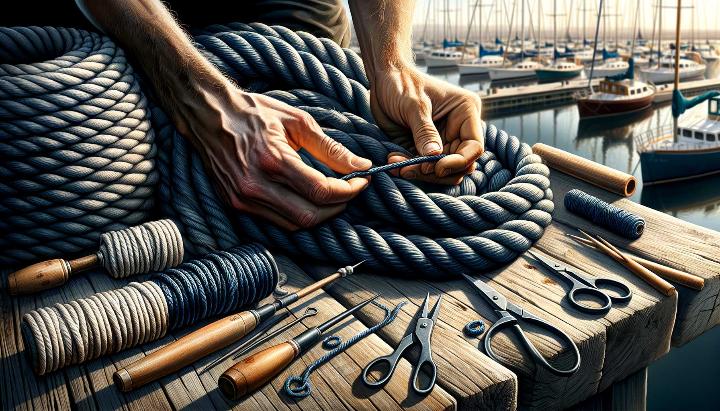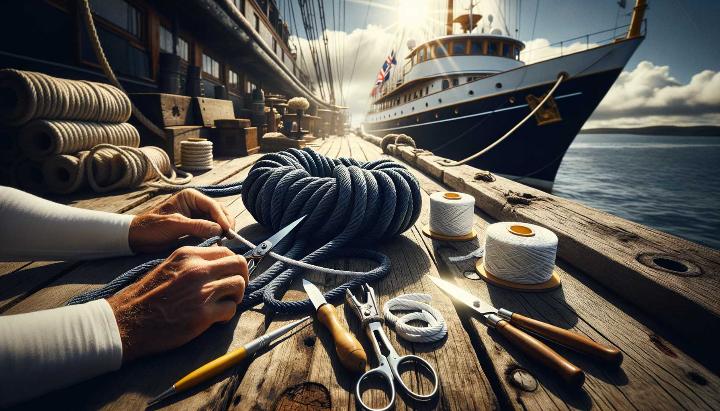Have you ever wondered how sailors create those seemingly indestructible knots that keep massive ships securely moored? The secret lies in the art of rope splicing, a skill that has been perfected over centuries and remains crucial in today's maritime industry. At iRopes, we've taken this ancient technique to new heights with our innovative 3 Strand Loop Splice featuring black Chafe Webbing—a game-changer in the world of mooring ropes.
In this comprehensive guide, we'll unravel the mysteries of different types of rope splicing techniques, exploring everything from the basics to advanced methods. Whether you're a seasoned sailor or a curious novice, you'll discover how different types of rope material and types of rope fibre influence splicing choices and performance. We'll delve into the intricacies of short splices, eye splices, back splices, and long splices, each serving a unique purpose in the vast world of rope work.
But why should you care about rope splicing? Beyond its practical applications, mastering these techniques can significantly enhance safety, efficiency, and durability in various industries. From yachting to industrial rigging, the right splice can mean the difference between success and failure. Join us as we explore the fascinating world of rope splicing and learn how iRopes is revolutionising the industry with our cutting-edge solutions.
Understanding the Basics of Rope Splicing
Have you ever marvelled at the intricate knots and joins on a well-crafted sailboat or wondered how rock climbers trust their lives to seemingly fragile ropes? The secret lies in the art of rope splicing. As a seasoned sailor and rope enthusiast, I've come to appreciate the beauty and functionality of this age-old technique.
Rope splicing is a method of joining ropes or creating loops without the use of knots. It's a skill that's been honed over centuries, and it's as relevant today as it was on ancient sailing ships. The beauty of splicing lies in its strength and sleek profile - a well-executed splice can be stronger than the rope itself and doesn't create the bulk that knots do.
Types of Rope Splices
There are three main types of splices that every rope aficionado should know:
- Eye splice: This creates a permanent loop at the end of a rope. I remember using this splice to create a secure anchor point for my first sailing dinghy.
- Back splice: Used to prevent the end of a rope from fraying. It's particularly useful for decorative ropes or those subject to frequent handling.
- Short splice: This joins two ropes together. I've used this countless times to repair broken halyards on sailboats.
Step-by-Step Guide to Splicing Rope
While the specific steps vary depending on the type of splice and rope material, here's a general overview of the process:
- Unlay the strands of the rope
- Interweave the strands according to the splice pattern
- Tuck the strands under and over each other
- Taper the splice by gradually reducing the number of tucks
- Trim excess strands and smooth out the splice
Remember, practice makes perfect. My first attempts at splicing looked more like bird's nests than professional joins, but with patience and persistence, you'll soon be creating splices that are both functional and beautiful.

To get started with rope splicing, you'll need a few essential tools:
- Fid: A tapered tool used to separate rope strands and guide them during splicing.
- Knife or scissors: For cutting rope and trimming excess strands.
- Whipping twine: Used to secure the ends of cut ropes to prevent fraying.
- Tape measure: To ensure your splices are the correct length.
As you delve deeper into the world of rope splicing, you'll discover that different rope materials require slightly different techniques. Three-strand rope is the most common for basic splicing, but you can also splice double-braid and hollow-braid ropes with the right know-how.
So, are you ready to elevate your rope work to the next level? Grab some rope, gather your tools, and start splicing. You'll be amazed at how quickly you can create professional-looking joins that are both strong and elegant. Happy splicing!
Exploring Common Rope Splicing Techniques
As we delve deeper into the world of rope splicing, it's time to explore the various techniques that can transform ordinary ropes into sturdy, functional tools. Each splicing method serves a unique purpose, and mastering these techniques can elevate your rope work to professional levels.
Understanding Eye Splices and Back Splices
Let's start with two fundamental splicing techniques that every rope enthusiast should know: eye splices and back splices.
- Eye splice: This technique creates a permanent loop at the end of a rope. I've used eye splices countless times on my sailing adventures, from securing halyards to creating anchor points. The beauty of an eye splice lies in its strength - when done correctly, it can retain up to 95% of the rope's original strength.
- Back splice: This handy technique prevents rope ends from fraying. I remember the first time I used a back splice on my climbing rope; it not only looked neat but also extended the rope's lifespan significantly.
To create these splices, you'll need a few essential tools:
- Fid or splicing needle: These tapered tools help separate rope strands and guide them during splicing.
- Sharp knife or scissors: For cutting rope and trimming excess strands.
- Whipping twine: To secure the ends of cut ropes and prevent fraying.
- Tape measure: Ensures your splices are the correct length.

Advanced Splicing Methods for Different Rope Types
As you gain confidence with basic splices, you can explore more advanced techniques:
- Short splice: This method joins two rope ends together, creating a strong connection without significantly increasing the rope's diameter. It's perfect for repairing broken ropes or creating custom lengths.
- Long splice: Similar to the short splice, but it maintains the rope's original diameter. This splice is ideal for applications where the rope needs to pass through pulleys or other tight spaces.
When working with different rope materials, remember that each type requires a slightly different approach. For instance, splicing three-strand twisted rope differs from splicing double-braid or hollow-braid synthetic ropes. Always consult specific guides for the rope type you're working with to ensure the best results.
Have you ever tried your hand at rope splicing? Whether you're a seasoned pro or a curious beginner, there's always something new to learn in this fascinating craft. Why not grab some rope and give one of these techniques a try? You might be surprised at how satisfying it is to create a professional-looking splice with your own hands.
Key Factors Influencing Rope Splicing Technique Selection
As a seasoned sailor, I've learned that choosing the right rope splicing technique is crucial for ensuring the safety and efficiency of any maritime operation. Let's dive into the key factors that influence this important decision.
Types of Rope Splicing Methods
Before we delve into the factors, it's essential to understand the main types of rope splicing methods:
- Eye splice: Creates a permanent loop at the end of a rope, perfect for securing lines to cleats or forming attachment points.
- Back splice: Prevents rope ends from fraying, ideal for extending the life of your lines.
- Short splice: Joins two rope ends together, maintaining nearly full strength of the original rope.
Each of these methods has its unique advantages, and the choice depends on various factors. Let's explore them.
Advantages and Disadvantages of Different Splicing Techniques
When selecting a splicing technique, consider these key factors:
- Rope material: Natural fibres like cotton or manila behave differently from synthetic materials like nylon or polyester. For instance, I find that eye splices work exceptionally well with three-strand nylon ropes commonly used in mooring lines.
- Intended use: The purpose of your rope greatly influences the splicing method. A back splice might be perfect for a dock line, while an eye splice is crucial for a halyard.
- Required strength: Different splices offer varying levels of strength retention. In my experience, a well-executed short splice can maintain up to 90-95% of the rope's original strength.
- Environmental conditions: Consider factors like exposure to UV rays, saltwater, or chemicals. I once used a synthetic rope with UV protection for a long-term mooring setup, and the splice held up remarkably well.

Remember, the goal is to create a splice that not only serves its purpose but also maintains the rope's integrity. A poorly chosen or executed splice can compromise the entire system, potentially leading to dangerous situations.
Have you ever found yourself in a situation where the wrong splice choice caused issues? Share your experiences in the comments below – we can all learn from each other's maritime adventures!
In the next section, we'll take a closer look at the iRopes 3 Strand Loop Splice with black Chafe Webbing, a technique that's gaining popularity in mooring applications. Stay tuned to learn how this innovative method combines strength and durability for superior performance in challenging marine environments.
Mastering the 3 Strand Rope Loop Splice
As a seasoned sailor, I've come to appreciate the artistry and practicality of rope splicing, especially when it comes to the 3 strand loop splice. This technique is a game-changer for creating sturdy, reliable connections in marine applications. Let me share with you the ins and outs of this essential skill, focusing on the iRopes 3 Strand Loop Splice with black Chafe Webbing – a method that's revolutionising mooring rope technology.
The beauty of a well-executed 3 strand loop splice lies in its strength and durability. When done correctly, it can retain up to 90% of the rope's original strength, far surpassing the reliability of knots. Plus, the addition of chafe webbing takes this splice to a whole new level of longevity.
Essential Tools and Materials for Splicing
Before we dive into the splicing process, let's gather our tools. Here's what you'll need:
- Fid or splicing needle: This tapered tool is your best friend for separating and weaving rope strands.
- Sharp knife or scissors: For clean cuts and trimming excess strands.
- Tape measure: Precision is key in splicing, so don't skip this!
- Whipping twine: To secure the ends and prevent fraying.
- Black chafe webbing: This is the secret ingredient for enhanced durability.
For the rope itself, a high-quality 3 strand rope is ideal. I prefer synthetic fibres like nylon or polyester for their strength and resistance to rot, especially in marine environments.

Step-by-Step Loop Splice Guide
Now, let's walk through creating a 3 strand loop splice with chafe webbing:
- Measure and mark: Determine the size of your loop and mark the rope accordingly. Remember, the splice will take up some length, so add about 20cm extra.
- Unlay the strands: Carefully separate the three strands at your marked point. This is where your fid comes in handy.
- Form the loop: Bring the working end around to form your desired loop size.
- Begin weaving: Start tucking each strand under an adjacent strand of the standing part of the rope. This is the trickiest part, so take your time.
- Continue tucking: Keep weaving each strand, always going over one and under one. Aim for at least three full tucks.
- Taper the splice: For a smooth finish, reduce the size of the strands on the final tuck.
- Add chafe webbing: Wrap the black chafe webbing around the splice, securing it at both ends. This crucial step protects against wear and tear.
- Trim and finish: Cut off any excess strands and use whipping twine to secure the ends if needed.
Remember, practice makes perfect. My first attempts were far from pretty, but with time, you'll develop a feel for the rope and create splices that are both functional and aesthetically pleasing.
The iRopes 3 Strand Loop Splice with black Chafe Webbing is particularly popular for mooring ropes, and for good reason. The added protection from the chafe webbing significantly extends the life of the rope, especially in harsh marine conditions where abrasion is a constant threat.
Have you tried your hand at this splicing technique? Whether you're a novice or an old salt, I'd love to hear about your experiences. Drop a comment below and let's swap splicing stories!
```htmlRope splicing is an essential skill across various industries, offering strong, sleek joins without the bulk of knots. Understanding different types of rope splicing techniques, like the eye splice, back splice, and short splice, broadens the utility of ropes in fields ranging from maritime to construction. The choice of splice hinges on factors like the type of rope fiber and different types of rope material, impacting load requirements and environmental suitability. The iRopes 3 Strand Loop Splice—with black Chafe Webbing—is renowned for its durability, particularly in mooring ropes, exemplifying precision in splicing for challenging conditions. By mastering these techniques, enthusiasts can enhance the lifespan and functionality of their rope-based projects. Discover more and extend your rope-handling skills to new heights with expert guidance.
Get Expert Insights on Custom Rope Solutions
Interested in exploring advanced rope splicing methods or seeking bespoke rope solutions? Fill in the form above to connect with our team of specialists at iRopes. Whether you're working with different types of rope splicing or require specific performance features, we are here to assist you in enhancing your projects and achieving unparalleled strength and durability in your applications.
```